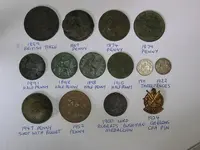As far as I know, the primary mechanism of olive oil soaking is this:
Corrosion particles have an affinity for the coin and for each other. Over time (a lot of time!) the oil "creeps" in between the particles and the coin's surface, reducing the strength of their interactions toward each other and the coin's surface. This allows them to float away. I'm oversimplifying things here- the surface chemistry can get rather complex, but I do not believe it actually removes from the metal surface of the coin. It doesn't add, either, with the possible exception of the darkening that some people report. Darkening of the copper is most likely from trace sulfur compounds in the oil, but I'm also thinking it could be from oxidized (rancid) molecules in the olive oil that produce copper oxides over a great deal of time. Olive oil is a plant product, and plants contain sulfur (just like animals do).
I have not researched yet whether the cleaning mechanism of olive oil is also due to traces of free fatty acids in the oil. This may in fact be true. However, mineral oil will also work (not sure if it works as well, need to do experiments), and this does not contain fatty acids-- just straight-chain hydrocarbons.
I don't know about those grading outfits, but I personally have no qualms about buying a coin that was olive oil soaked, if that's all that was done to it. If a coin is nothing more than a corroded copper slug with no detail, you have nowhere to go but up. I've heard conservators say they like electrolysis, but I have some big reservations about it. On copper coins it can quite easily give the surface an overcleaned appearance. It also runs the risk of chemically reducing some of the corrosion back into a metal coating that doesn't want to come off the surface... this would essentially be "re-plating" the coin with its own former metal content. Typically, though, most of the corrosion that's reduced to metal will actually flake off the coin and into the electrolyte.






 Monty
Monty